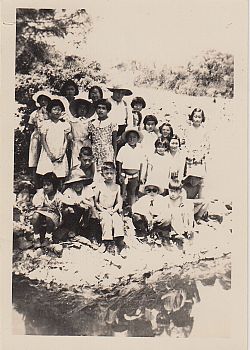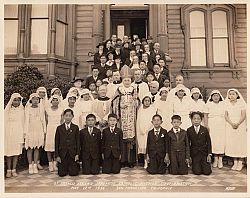Priest voluntarily lived at Topaz internment camp
Friday, Oct. 09, 2015

Archdiocese of San Francisco Archives
Photo 1 of 2
Fr. William Stoecke cares for Japanese-American people in the early part of the 20th century. Courtesy photo/Archdiocese of San Francisco Archives
During our year-long tribute to the religious orders who have served in the Diocese of Salt Lake City, we have naturally focused mostly on those orders like the Holy Cross Sisters and the Daughters of Charity that have sent many members here and whose service has been most notable. We conclude the series this month, however, with a look at the Society of the Divine Word (SVD), which has perhaps sent the fewest members here (only two to date), but whose service is nevertheless worthy of celebration.
The Society is a missionary order (at present the largest such order in the Church) founded in The Netherlands in 1875 and composed during its early years mostly of German priests. Its members have distinguished themselves by their missionary zeal and their willingness to serve in the most remote parts of the earth – particularly Asia and Africa – to bring the Gospel to people who have never heard the Christian message. In Utah since 2011 we have had Father Reynato Rodillas, pastor of St. Olaf Parish in Bountiful, though he recently left the order for incardination as a diocesan priest.
The story we will examine here, however, is that of Fr. William Stoecke, SVD, who was assigned to Utah for three years during World War II.
Fr. Stoecke was born in Hanover, Germany in 1877. He studied for ordination in the Society of the Divine Word at their seminary in Steyl, Netherlands, where the order was founded (SVD priests are sometimes known as “Steyler missionaries”). After his ordination in Austria in 1908, he began the first of three periods of service in the United States. Perhaps the defining period in his priesthood, though, was the 11 years (1909-20) that he served as a missionary in the port city of Akita, Japan, and became head of the Japanese Catholic missions there. He returned to the U.S. in 1920 to serve as pastor of a parish in the Midwest, but in 1925 the Order sent him to San Francisco to minister to the Japanese Catholic community there.
Fr. Stoecke was still in San Francisco when World War II broke out, and he became a close witness to the atrocious treatment our government meted out to the Japanese-Americans on the Pacific Coast, a hard-working and loyal ethnic minority people who in many cases represented the embodiment of the American Dream.
According to Executive Order 9066 in 1942, Japanese-Americans on the coast were given two weeks to dispose of their property, pack up, and prepare to be “relocated” to concentration camps in the interior where, as suspected spies, they would not be able to sabotage the war effort. Americans of neither German nor Italian descent were subjected to such treatment.
Fr. Stoecke’s flock was sent first down the peninsula to San Bruno, where a former racetrack called Tanforan was converted into a temporary holding facility while the concentration camps in the interior were hastily thrown together. Fr. Stoecke himself remained in San Francisco, but was in close contact with the internees: “We are able to give them the proper spiritual assistance,” he reported, “besides receiving the sacraments regularly, they cultivate as in the [St. Francis Xavier Catholic] mission, private devotions, rosary, way of the cross, etc. So far so good – even a few baptisms could be recorded within 2 weeks.”
In October 1942, Fr. Stoecke’s flock of Japanese Catholics were sent to Topaz, a crudely constructed community of tarpaper shacks some 15 miles west of Delta, Utah. The 65-year-old Fr. Stoecke decided he would be a prisoner, too. He came with them, living first on the Nutsch family farm six miles from Delta for two years, then on Block 2 of Topaz itself from 1944-45, shivering with the Japanese-American internees through the winter cold and baking with them through the summer heat.
Most people would regard Topaz as a hardship assignment, but Stoecke endured it all joyfully. “So far the winter was not too cold,” he wrote before his first Christmas to San Francisco Archbishop John J. Mitty (who had been Bishop of Salt Lake from 1926 to 1932), “what it will be later I don’t know.” He closed, “It gives me indeed pleasure to labor, in a modest way, in your former diocese and I ask humbly [you] to bless my work out here and myself.”
Stoecke was a diligent record keeper, so we have an accurate idea of the nature of his energetic ministries at Topaz. In addition to daily morning Mass, he celebrated Mass on Sundays and holy days. By the time the camp closed in September, 1945, he had recorded 25 baptisms, four funerals, three weddings, more than 900 confessions and 2,000 Holy Communions. At one point, the Most Rev. Duane G. Hunt, fifth Bishop of Salt Lake, travelled to Topaz to administer 20 confirmations.
Stoecke assumed responsibility for Catholic staff members and also for the Catholics in nearby Sugarville, where he recorded 300 confessions and 450 Holy Communions. Because he had both English- and Japanese-speaking parishioners, he gave his homilies in both languages. He was a most energetic priest.
After the war, Fr. Stoecke returned to San Francisco to pastor St. Francis Xavier Parish until 1951, and continued there in semi-retirement until 1963. In loving tribute to their loyal pastor, Japanese-American Catholics jammed the church to celebrate his 50th year of priestly ministry. During that celebration he remembered that the Topaz experience “was a revelation to me.” The Topaz inmates, he went on, “had to leave almost everything behind them. They lost most of what they had. But they took it as it had to be taken, without saying too much.”
When he died on June 4, 1963, Fr. Stoecke had compiled a record as one of the Diocese of Salt Lake City’s truly distinguished priests.
For questions, comments or to report inaccuracies on the website, please CLICK HERE.
© Copyright 2024 The Diocese of Salt Lake City. All rights reserved.
© Copyright 2024 The Diocese of Salt Lake City. All rights reserved.


Stay Connected With Us